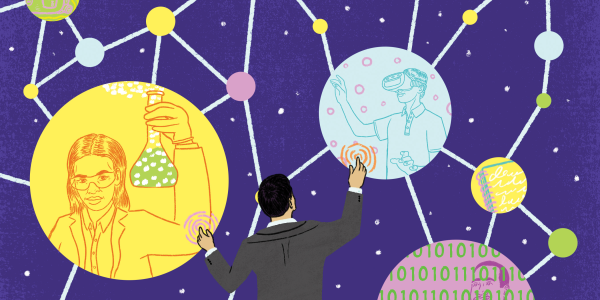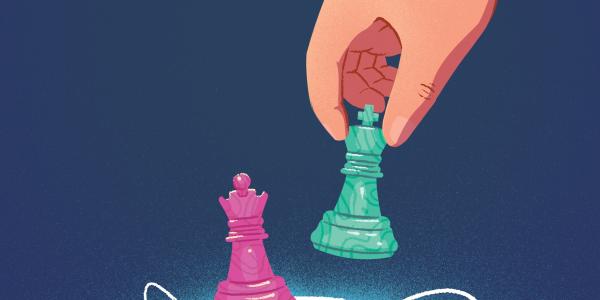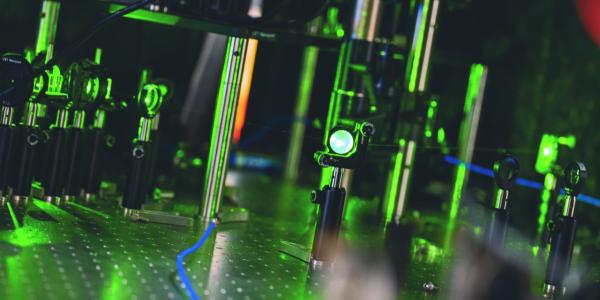Picture a scientist or scholar at work. Do you see them in a library? A lab surrounded by beakers and microscopes?
Maybe they’re out in the field taking soil samples or conducting interviews. While these tried-and-true methods still have a place in many researchers’ toolkits, the rapid rise of big data, artificial intelligence, and other digital tools has significantly reshaped the academic landscape.
To take advantage of these once-in-a-generation developments, Arts & Sciences launched a digital transformation initiative to recruit some of the brightest minds in nearly every field. Spearheaded by Feng Sheng Hu, the Richard G. Engelsmann Dean of Arts & Sciences, that effort has led to the hiring of nearly 20 digital and data specialists, the creation of new computational tools, unprecedented collaboration across disciplines, and groundbreaking discoveries.
We invite you to step inside the research lab of the future to see how Arts & Sciences’ faculty members are transforming their fields of study.

Putting digital culture under the microscope
Raven Maragh-Lloyd explores the role of non-traditional activism and social media algorithms.
Raven Maragh-Lloyd knew that building an academic career around the constantly evolving fields of politics, culture, and technology would require a focus on the bigger picture: “I learned early in my career that I chose to study a moving target.”
Joining WashU in 2021 as an assistant professor of African and African American studies and film and media studies was a “dream job,” allowing her to focus on both areas equally as she explored culture, race, and Blackness in digital media.
In 2024, Maragh-Lloyd published her first book, “Black Networked Resistance: Strategic Rearticulations in the Digital Age,” a counter-narrative to mainstream ideas about Black activism during the early years of the Black Lives Matter movement. “I wanted to make visible the non-traditional forms of activism that I saw Black users engaging in online that weren’t getting as much traction and legitimization,” she said.
Read more about Maragh-Lloyd’s work here.

Testing chemistry at the computer
Robert Wexler uses computational power to see new possibilities for green energy.
Not all chemists work with pipettes and bubbling flasks. Robert Wexler, an assistant professor of chemistry, uses the principles of quantum physics and high-powered computing to predict and design new materials that could help fuel a revolution in green energy.
Through digital chemistry, Wexler can tinker with compounds and discover new combinations without ever entering a lab. “Running simulations of different materials isn’t just useful for discovery,” he said. “It’s really helpful for understanding how a material works at the atomic level.”
Wexler, previously a postdoctoral researcher at Princeton University, came to WashU in 2022 under Arts & Sciences’ digital transformation initiative. “I was excited to join a university where so many researchers were taking a computational approach in their various fields,” he said. “I knew I would fit right in.”
Read more about Wexler’s work here.

Examining disinformation by the numbers
Christopher Lucas takes a data-driven approach to investigating our most pressing political questions.
Christopher Lucas spends a lot of his time researching how digital technology affects American political attitudes — a topic that, for many, triggers a sense of existential dread. But Lucas’s innovative research has found there might be less to worry about than previously feared.
In 2020, the associate professor of political science set out to study the impact of political deepfakes, synthesized video and audio clips in which a person’s face, body, or voice has been digitally altered. “There’s a popular perception that this type of media will undermine our ability to learn accurate information about politics,” he said. But after surveying more than 5,700 people nationwide, he found that deepfake videos had no greater influence on the American public than any other type of disinformation campaign.
For another study, Lucas and colleagues turned their focus to YouTube’s recommendation algorithms. They wanted to know if the algorithms sent people down online rabbit holes that led to politically extreme content, or if people who ended up viewing extremist videos had a preexisting appetite for them. Once again, they found no evidence that the algorithms fueled political extremism.
Read more about Lucas’s work here.
A computer-powered approach to the cosmos

Yajie Yuan simulates the enormous energies streaming from black holes and neutron stars.
Modern computers can’t model entire universes, but Yajie Yuan has found a way to program approximations of the most enigmatic objects in the cosmos — black holes.
“Starting with basic principles of physics, I use computer simulations to predict the activity of charged particles and electromagnetic fields around black holes and neutron stars,” said Yuan, an assistant professor of physics who joined WashU in 2022. “WashU has a great team of researchers who are making observations of these objects, so coming here gave me a chance to combine my theoretical work with real-world findings.”
Yuan completed her undergraduate education at Tsinghua University in her home country of China. She went on to earn a PhD at Stanford before completing postdoctoral fellowships at Princeton and the Center for Computational Astrophysics at the Flatiron Institute in New York City.
Her work on astrophysics was a natural fit for Arts & Sciences’ digital transformation initiative. “The initiative emphasizes using modern tools to make important discoveries,” she said. “I was excited by the chance to collaborate with others who have a similar mindset.”
Read more about Yuan’s work here.
Making the smartphone a stage

Elizabeth Hunter harnesses AI to find new ways for theater to survive and thrive.
What does it mean to go to the theater? While the industry has long faced its share of challenges — the 2020 pandemic among them — the rise of digital technology has introduced new possibilities for live performance. “Those of us who study theater have a long history of thinking about things like presence, intimacy, audience impact, and live participation,” said Elizabeth Hunter, an assistant professor of drama. “New technologies can help theater build on this history to survive and thrive in the digital age.”
The latest project from Hunter’s theater and new media lab, Fabula(b), leverages digital techniques to reimagine audience participation. Using augmented reality, artificial intelligence, motion capture, and physical performance, the lab is currently resurrecting the work of Henry “Box” Brown, a formerly enslaved person who escaped in 1849 by mailing himself in a wooden crate from Virginia to Philadelphia. Brown went on to become a celebrated author, speaker, and performer in a popular style of live theater called “panorama,” which used moving painted scenery as a backdrop. Brown’s moving panorama, “Mirror of Slavery,” depicted the evils of slavery, his escape, and a future with universal emancipation.
Read more about Hunter’s work here.
This story appeared in the Spring 2025 issue of Ampersand magazine. See more stories from the magazine and browse our archives.





